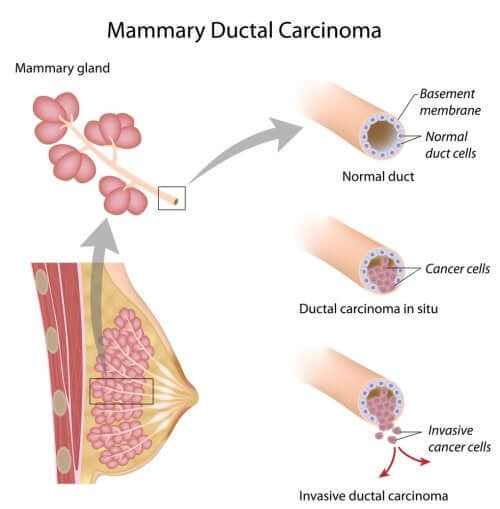The Biology of Breast Cancer: Origin and Types


Written and verified by the biologist Olga Carbajo
Why is studying the biology of breast cancer crucial in the fight against this disease? It’s always been said that the best way to defeat your enemy is to know it – to know how it behaves, and discover its weaknesses. This is exactly what molecular and cellular biology does, by analyzing the differences between healthy cells and cancer cells.
The results obtained in these tumor behavior studies allow the medical community to develop better therapeutic strategies. In the same way, they can design less harmful treatments.
Recently, Australian researchers discovered a communication line between healthy and cancer cells. It shed some light on the most aggressive subtype, triple-negative, and gives hope to women who are suffering from it.
How does breast cancer originate? Tumor biology
The correct term to refer to this process is carcinogenesis, which is the phenomena that determines the appearance and development of a tumor. Such risk factors include:
- Firstly, genetic inheritance.
- Also, endogenous and exogenous estrogen.
- Spontaneous mutations.
- Finally, chemical and physical carcinogens.
The process begins with the irreversible alteration of the original DNA molecule. Consequently, gene expression is modified and erroneous proteins are produced.
In the case of breast cancer, the altered proteins that act as carcinogens or tumor initiators are: estrogen, prolactin, and progesterone. The result is uncontrolled cell growth that leads to the manifestation of cancer.

Types of breast cancer
Not all types of breast cancer are the same. Analyzing the development and origin of the tumor is crucial when it comes to deciding the treatment plan. The biology of breast cancer establishes a classification of the various tumors based on different criteria.
- The classification depends on the affected area, whether it’s the lobules, ducts, or intermediate tissue. This is vital, since the place the tumor originated determines its development.
- The appearance of tumor cells in a microscope allows medical professionals to classify them into subtypes: tubular, medullary, and papillary. So consequently, they can select the best treatment plan.
- Or, unfortunately, if they’re recurrent or metastatic. In these cases, it’s necessary to study the degree of cellular differentiation. This term refers to cell maturation or its age. Breast cancer is classified into three degrees. The third is considered the most aggressive.
In this pre-classification, we haven’t discussed the important genetic component that marks the development of cancer. Also, the analysis of these genetic factors may allow a correct sub-classification of the different types of tumors.
What genes are affected?
Eva Ciruelos, medical oncologist at the Hospital 12 de Octubre and president of the SOLTI Breast Cancer Research Group, recently held conferences to discuss the latest advances in breast cancer research. During her speech, she stressed the importance of knowing the genetic origin of tumors:
“We need to know this information to properly sub-classify the pathology beyond luminal, triple-negative, and HER2.”
– Eva Ciruelos –
Therefore, these three classic types Dr. Ciruelos mentioned and whose treatment depends on the sub-classification are:
- Luminal. All tumors that are hormone-receptor-positive. In this regard, if they’re positive for the progesterone receptor, they belong to subtype Luminal A and, if negative, to Luminal B.
- Triple-negative. This classification includes breast tumors that test negative for estrogen and progesterone receptors and HER2.
- HER2. This type includes tumors with the “epidermal growth factor receptor 2, HER2” oncogene.

Some hope
Thanks to the information obtained by the research teams on the biology of breast cancer, a lot of progress has been made regarding treatment options.
After decades of research, current scientific teams can focus on relevant aspects, such as cell proliferation or the immune system reactions against tumors. In fact, the discovery of cancer stem cells has been a major breakthrough in the classification of tumors. Without research, there’s no cure.
Why is studying the biology of breast cancer crucial in the fight against this disease? It’s always been said that the best way to defeat your enemy is to know it – to know how it behaves, and discover its weaknesses. This is exactly what molecular and cellular biology does, by analyzing the differences between healthy cells and cancer cells.
The results obtained in these tumor behavior studies allow the medical community to develop better therapeutic strategies. In the same way, they can design less harmful treatments.
Recently, Australian researchers discovered a communication line between healthy and cancer cells. It shed some light on the most aggressive subtype, triple-negative, and gives hope to women who are suffering from it.
How does breast cancer originate? Tumor biology
The correct term to refer to this process is carcinogenesis, which is the phenomena that determines the appearance and development of a tumor. Such risk factors include:
- Firstly, genetic inheritance.
- Also, endogenous and exogenous estrogen.
- Spontaneous mutations.
- Finally, chemical and physical carcinogens.
The process begins with the irreversible alteration of the original DNA molecule. Consequently, gene expression is modified and erroneous proteins are produced.
In the case of breast cancer, the altered proteins that act as carcinogens or tumor initiators are: estrogen, prolactin, and progesterone. The result is uncontrolled cell growth that leads to the manifestation of cancer.

Types of breast cancer
Not all types of breast cancer are the same. Analyzing the development and origin of the tumor is crucial when it comes to deciding the treatment plan. The biology of breast cancer establishes a classification of the various tumors based on different criteria.
- The classification depends on the affected area, whether it’s the lobules, ducts, or intermediate tissue. This is vital, since the place the tumor originated determines its development.
- The appearance of tumor cells in a microscope allows medical professionals to classify them into subtypes: tubular, medullary, and papillary. So consequently, they can select the best treatment plan.
- Or, unfortunately, if they’re recurrent or metastatic. In these cases, it’s necessary to study the degree of cellular differentiation. This term refers to cell maturation or its age. Breast cancer is classified into three degrees. The third is considered the most aggressive.
In this pre-classification, we haven’t discussed the important genetic component that marks the development of cancer. Also, the analysis of these genetic factors may allow a correct sub-classification of the different types of tumors.
What genes are affected?
Eva Ciruelos, medical oncologist at the Hospital 12 de Octubre and president of the SOLTI Breast Cancer Research Group, recently held conferences to discuss the latest advances in breast cancer research. During her speech, she stressed the importance of knowing the genetic origin of tumors:
“We need to know this information to properly sub-classify the pathology beyond luminal, triple-negative, and HER2.”
– Eva Ciruelos –
Therefore, these three classic types Dr. Ciruelos mentioned and whose treatment depends on the sub-classification are:
- Luminal. All tumors that are hormone-receptor-positive. In this regard, if they’re positive for the progesterone receptor, they belong to subtype Luminal A and, if negative, to Luminal B.
- Triple-negative. This classification includes breast tumors that test negative for estrogen and progesterone receptors and HER2.
- HER2. This type includes tumors with the “epidermal growth factor receptor 2, HER2” oncogene.

Some hope
Thanks to the information obtained by the research teams on the biology of breast cancer, a lot of progress has been made regarding treatment options.
After decades of research, current scientific teams can focus on relevant aspects, such as cell proliferation or the immune system reactions against tumors. In fact, the discovery of cancer stem cells has been a major breakthrough in the classification of tumors. Without research, there’s no cure.
All cited sources were thoroughly reviewed by our team to ensure their quality, reliability, currency, and validity. The bibliography of this article was considered reliable and of academic or scientific accuracy.
- infosalud.es (21 de marzo 2109). descubren que el cáncer de mama se comunica con las células normales para expandirse y sobrevivir [artículo en web]. Recuperado de : www.mundodelasalud.com
- Mayo Clinic. (24 de enero 2019).Tipos de cáncer de mama: qué significa tu tipo [artículo en web]. Recuperado de www.mayoclinic.org
- breast cáncer. (20 abril 2017). tipos de cáncer [reseña en web]. recuperado de : www.breastcancer.org
- Hernández, D. (Septiembre 2016). Biología del cáncer. [Artículo en revista].Recuperado de Revista venezolana de oncología. Redalyc.org
- Pulido. S. (1 marzo 2019). Subclasificar tumores en cáncer de mama [artículo en revista divulgativa]. Recuperado de www.gacetamedica.com
- Instituto Nacional del Cáncer. (30 noviembre 2016).Investigación de la biología del cáncer. [artículo en revista digital científica]. Recuperado de: www.cancer.gov
This text is provided for informational purposes only and does not replace consultation with a professional. If in doubt, consult your specialist.








